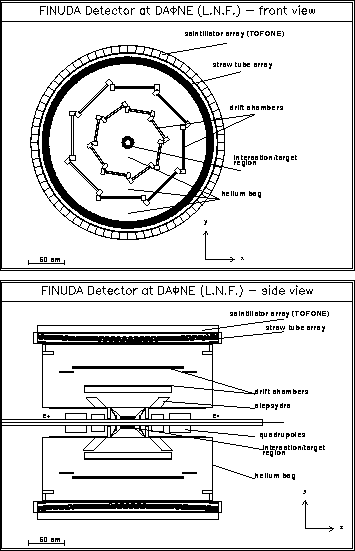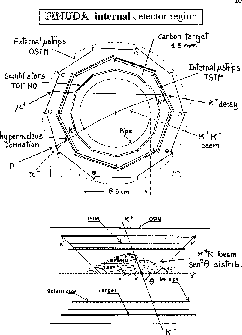 , naturally
rejecting background from Bhabha scattering.
, naturally
rejecting background from Bhabha scattering.
FINUDA (figg.1) is a magnetic spectrometer with
cylindrical geometry,
optimized in order to have large solid angle, optimal momentum resolution
and good triggering capabilities. Geometrical acceptance
is approximately  , naturally
rejecting background from Bhabha scattering.
, naturally
rejecting background from Bhabha scattering.
FINUDA consists of (figg.2,3):
 ) pairs from
) pairs from  decay emerge from the interaction
region, whose dimensions are
decay emerge from the interaction
region, whose dimensions are  = 2 mm,
= 2 mm,
 = 0.02 mm,
= 0.02 mm,  = 3 cm.
The (
= 3 cm.
The ( ) pairs follow a
) pairs follow a  law,
law,  being the angle relative to the z-axis.
being the angle relative to the z-axis.

Figure 2: Sketch of the FINUDA detector beam view (top) and side view (bottom).
The FINUDA spectrometer must provide a momentum resolution on
the prompt  of the order of
of the order of
 fwhm, negligible when compared to the momentum degradation due to
multiple scattering.
Optimization for prompt pions from
fwhm, negligible when compared to the momentum degradation due to
multiple scattering.
Optimization for prompt pions from  -hypernuclei has shown
that a magnetic field higher that 1 T is needed: when applied to a 2m-long by
1m-radius detector volume, electrical power consumption considerations
have suggested to adopt the superconducting option.
The FINUDA magnet
is a superconducting solenoid
whose magnetic axis is along the beam direction, providing a highly uniform
-hypernuclei has shown
that a magnetic field higher that 1 T is needed: when applied to a 2m-long by
1m-radius detector volume, electrical power consumption considerations
have suggested to adopt the superconducting option.
The FINUDA magnet
is a superconducting solenoid
whose magnetic axis is along the beam direction, providing a highly uniform
 = 1.1 T magnetic field (max disuniformity of 5% at the outer edges
of the tracking volume).
The tracking volume is generated by rotating a trapezium
with
= 1.1 T magnetic field (max disuniformity of 5% at the outer edges
of the tracking volume).
The tracking volume is generated by rotating a trapezium
with  20 cm,
20 cm,  180 cm bases, and 120 cm height.
The iron yoke has an octagonal shape, with two endcaps that can be open
vertically to access the detector.
180 cm bases, and 120 cm height.
The iron yoke has an octagonal shape, with two endcaps that can be open
vertically to access the detector.
The cylindrical interaction/target region of FINUDA (fig.3) consists of the beam pipe, a scintillator barrel (TOFINO), an internal octagonal Si microstrip array (ISIM) and the nuclear stopping target. The above arrangement must accomplish the following tasks:
 ) pairs from
) pairs from  decay for triggering,
exploiting the back-to-back event topology and identification
by ionization energy loss
decay for triggering,
exploiting the back-to-back event topology and identification
by ionization energy loss  (TOFINO);
(TOFINO);
 ) coordinates before the nuclear target
with
) coordinates before the nuclear target
with  , also providing particle identification
by
, also providing particle identification
by  with triggering capabilities (ISIM);
with triggering capabilities (ISIM);
 as near as possible to the external
surface of the target;
as near as possible to the external
surface of the target;
The thicknesses needed for the inner detectors are determined by the
requirement of stopping the  as close as possible to the outer surface of
the target, taking also into account its energy straggling
and
as close as possible to the outer surface of
the target, taking also into account its energy straggling
and  angular distribution.
Typical material thicknesses are: 400
angular distribution.
Typical material thicknesses are: 400  m Be for
the beam pipe, 2.0 mm for the TOFINO, 300
m Be for
the beam pipe, 2.0 mm for the TOFINO, 300  m
for ISIM and finally about 1.5 mm for a C stopping target.
With this setup
m
for ISIM and finally about 1.5 mm for a C stopping target.
With this setup  emitted from 45
emitted from 45 to 135
to 135 stop inside the target.
The length of the interaction/target region is determined by the
requirement of accepting all the (
stop inside the target.
The length of the interaction/target region is determined by the
requirement of accepting all the ( ,
,  ) pairs emitted from
45
) pairs emitted from
45 to 135
to 135 along z coordinate from -3.5 cm to +3.5 cm, which corresponds
to the fwhm of the (
along z coordinate from -3.5 cm to +3.5 cm, which corresponds
to the fwhm of the ( ,
,  ) interaction region.
The resulting length of
the target will be 17 cm and will allow an acceptance for
(
) interaction region.
The resulting length of
the target will be 17 cm and will allow an acceptance for
( ,
,  ) of more than 90%.
) of more than 90%.
The TOFINO consists of 12 strips, each 2.0 mm-thick, 14 cm-long and
2.5 cm-wide, subtending a polar angle
 . The strips are arranged following a
circumference of radius 5.5 cm, and are read by Hybrid Photo
Multiplier Tubes (HPMT). HPMT operate in the 1.1 T magnetic field and
are very compact.
. The strips are arranged following a
circumference of radius 5.5 cm, and are read by Hybrid Photo
Multiplier Tubes (HPMT). HPMT operate in the 1.1 T magnetic field and
are very compact.
The two silicon microstrip arrays ISIM (in the interaction/target region)
and OSIM (in the outer tracker) are composed of 18 modules in
total. Each module is made of three  thick,
thick,  double-sided (
double-sided ( and
and  strips)
Si wafers bonded together. Pitch is
strips)
Si wafers bonded together. Pitch is  , strip width is
, strip width is
 for a total of
for a total of  strips.
strips.

Figure 3: Sketch of the interaction/target region.
The external tracker consists of a ten-sided outer silicon microstrip detector (OSIM), two sets of planar low-mass drift chambers (LMDC) and an array of straw tubes (ST), all immersed in a He atmosphere, with the following tasks:
 from
the hypernucleus production very close to the target,
determining the position of the
from
the hypernucleus production very close to the target,
determining the position of the  stopping point and therefore correcting for the energy lost
in the thin target, further improving in momentum resolution (OSIM);
stopping point and therefore correcting for the energy lost
in the thin target, further improving in momentum resolution (OSIM);
 trajectory in the
trajectory in the  plane, with high resolution and
maximal transparency;
plane, with high resolution and
maximal transparency;
The LMDC are two sets of planar drift chambers using a He-based gas mixture,
each one with a  (inner chambers) and
(inner chambers) and
 (outer chambers) area.
Measurement of the coordinate along the wire is made by means of charge
division.
(outer chambers) area.
Measurement of the coordinate along the wire is made by means of charge
division.
The ST array is composed of
2424 0.03 mm-thick aluminized mylar straws with an inner diameter of 15 mm,
and a 255 cm length. The straws are arranged in three superlayers, each
superlayer made of two layers staggered by approximately half diameter. The
inner superlayer is axial, the two outer superlayers are stereo oriented at
 .
.
Finally, the outer scintillator array (TOFONE) will provide a fast logic
signal for the DAQ trigger (multiplicity and coincidence of the prompt  with the TOFINO signal) and neutron detection (with a
with the TOFINO signal) and neutron detection (with a  15% efficiency).
The TOFONE is composed of 72 slabs of plastic scintillator, 255 cm-long and
10 cm-thick, read-out at both ends by
15% efficiency).
The TOFONE is composed of 72 slabs of plastic scintillator, 255 cm-long and
10 cm-thick, read-out at both ends by  deflector prisms
and lightguides funnelling
the light signal to photomultipliers located in a low-field region outside of
the magnet.
deflector prisms
and lightguides funnelling
the light signal to photomultipliers located in a low-field region outside of
the magnet.